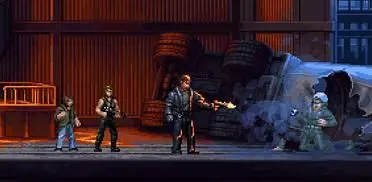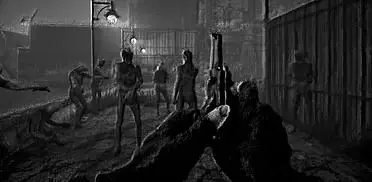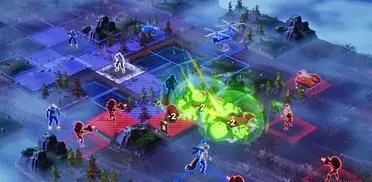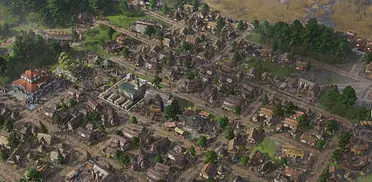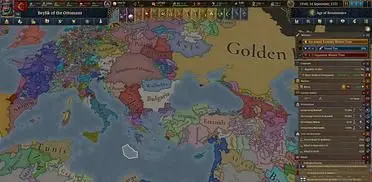There are only a handful of games with the respectable ongoing legacy of EVE Online. The unpredictability and scope of its persistent universe is legendary, offering thousands of players unparalleled freedom to scheme, expand, and wage war in a massive sci-fi setting. Starborne, an online 4x strategy game made by former EVE developers, aims to replicate that unique player relationship with the game world through the lens of a top-down strategy game instead of a 3D visualisation of an Excel sheet.
“The most obvious technical challenge is that such a huge world needs to be incredibly performant,” says Stefán Gunnarsson, CEO & Lead Designer of Starborne’s developer Solid Clouds. “It has always been a core pillar that our players should be able to enjoy and traverse the world with absolutely no lag, and while achieving that certainly was a challenge, there are other challenges not as immediately apparent. For example, the world always needs to be visually coherent; aesthetically pleasing, but strategically parsable from multiple different zoom levels.”
In order to achieve that sense of scale in an easily accessible manner, the game takes a cue from Galactic Civilisations’ rule book by representing artistic unrealistic versions of stellar bodies; planets, stars, and ships/space stations are vastly different in size in relation to each other than they would be in real life. The map is segmented by 750,000 hexes that compose sectors, and 5130 players must expand out of their starting clusters into the surrounding territory.
“A unique challenge for Starborne is level designing world maps on such a massive scale,” Gunnarsson says. “Our maps need to provide each player with his own starting area that he can expand his empire into, but at the same time we need to be mindful of the fact that not everyone will play out the entire 8-week game round, so spatially we need to ensure that there will not be dead zones. Finding a harmony in the design took a lot of trial and error, but is now at a place where we can keep the game busy and fun throughout the entire game round. This is constantly evolving, and as we approach the open beta launch we will reveal an updated game map that is based on all the lessons we’ve learned in this last alpha.”
“Our current plans for Starborne is to keep the map layer completely 2D – it makes a lot of sense for a game set in space where it would be easy to become disorientated,”</b> he continues. “We have high ambitions and we’ll continue to build out the Prosper engine, which alongside Unity3D is the backbone for the game. For our follow-up titles – which could, for example, happen on the same scale but within a fantasy, cyberpunk or post-apocalyptic setting – we will introduce verticality to the map.”
Unlike most strategy games, Starborne is online-only. Each game lasts a few months, pitting players against each other and allowing for all manners of agreements, alliances, and backstabbing to occur – something at the heart of the design philosophy.
“From the first moment you join the game we want you to see the gameworld absolutely buzzing with life. We want the biggest battles and wars to leave their mark and be visible on the map,” explains Haukur Steinn Logason, Solid Clouds’ Head of Marketing & Growth. “And while subterfuge plays a key role in Starborne, we want every player to be able to see the positions of key alliance stations and forward operating bases. Empire borders are about to become even more beautiful; they will illuminate the political landscape of Starborne, offering a stark contrast between modest player empires, powerful alliances, and incredible coalitions, and filling the world with an immediate sense of tension as players move to expand their borders in order to maximize their area of influence.”
Due to the MMO-like nature of a game thats keeps running regardless of how many people are playing it, Starborne needs to manage the unique situation of allowing players to play as long as they like while encouraging players to return day after day via long-term building queues.
“Overall, we want players to play Starborne with vigour,” says Gunnarsson. “That sometimes means we need to help people pace themselves – playing Starborne is not a sprint, as the design has players hit a natural point of diminishing returns. However, Starborne is a deeply political game, so in earnest, players can continue playing for hours on end if they want to – planning paths to success for their alliance, scouting the competition, engaging in subterfuge, and countless other ways that will pave the path to victory.”
When asked about the future, the devs reveal ambitious plans, including the possibility of infinite games instead of the current weeks-long expiration date.
“The map has always been at the forefront of Starborn, so, it makes sense to continue to build upon its success,” says Logason. “Our upcoming Tournament Server will include the first iteration of map pins, which will help players communicate, plan expansions and attacks, and set goals. This will continue to be one of our biggest priorities leading into open-beta and beyond.”
“A much-requested feature, which we will also be introducing, is the exportation of spy reports. Sharing intelligence within your alliance has up until now been pretty cumbersome; beyond the open-beta, we will start exposing more of the game state and activity to the web.”
As an ambitious studio with a number of EVE developers within its ranks, it’s perhaps no surprise that Starborne was inspired by some of its main traits and chose to make waves instead of going through a less exciting, subsided path.
“A lot of the influence and similarities between Starborne and EVE have become clear now in hindsight. Both games are player-driven, deeply political, and set in space,” says Gunnarsson. “In 2014, our founding team and the EVE veterans that would join the team agreed that the political intrigue and the strong community were the most successful elements that could inspire Starborne – those were pillars we wanted to emulate. That is why our fourth hire into Solid Clouds would become a community manager.”
But as important as CCP Games’ famous product was to Starborne’s development, Solid Clouds’ baby has moved past EVE’s shadow into a respectable and completely different beast of its own. And according to its creators, its growing influence will continue to be felt for years to come.
“Both studios are based in Reykjavik, which has a population of around 240,000. Naturally, a lot of knowledge sharing takes place because of that intimate proximity,” said Gunnarsson. “After many moons of development, with harsh weather conditions and a brutal lack of sunshine in the winter months, we are super proud to present the results to the world! During that time, our studio headcount has tripled, and many of the original EVE developers have moved on to new challenges. Starborne and Solid Clouds as a studio has developed its own unique character and identity and has started inspiring the next generation of game makers in Reykjavik.”
Starborne is currently in alpha testing, which you can check out on the official website, if you fancy giving it a go before it reaches its expected release date of late 2020.




